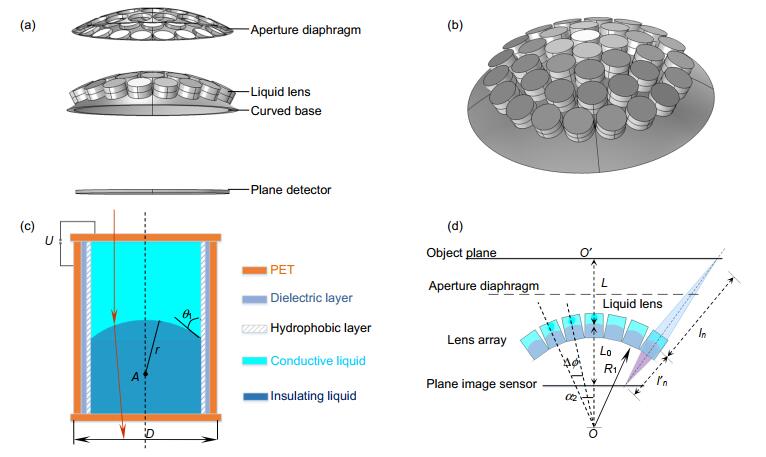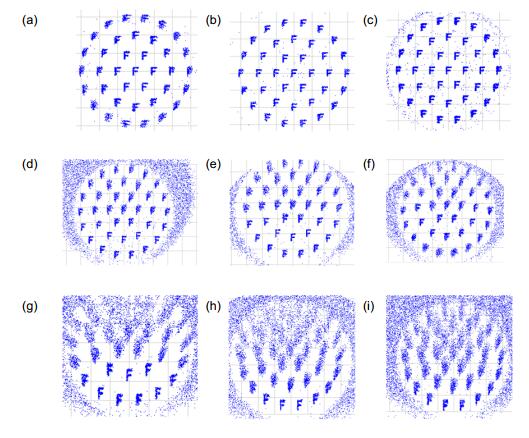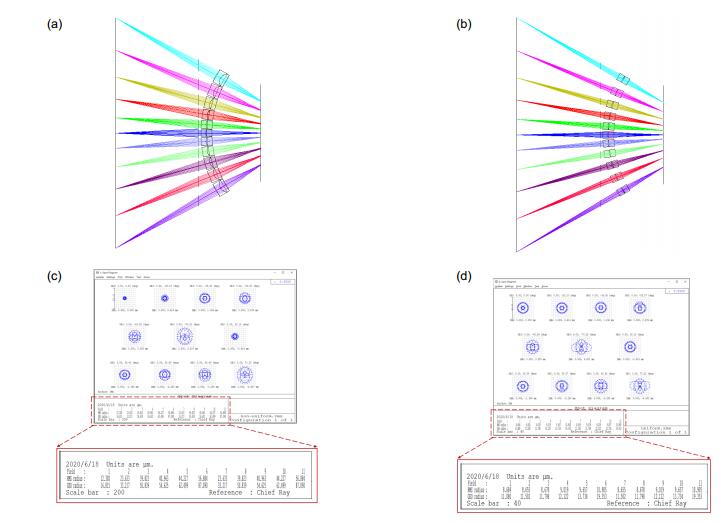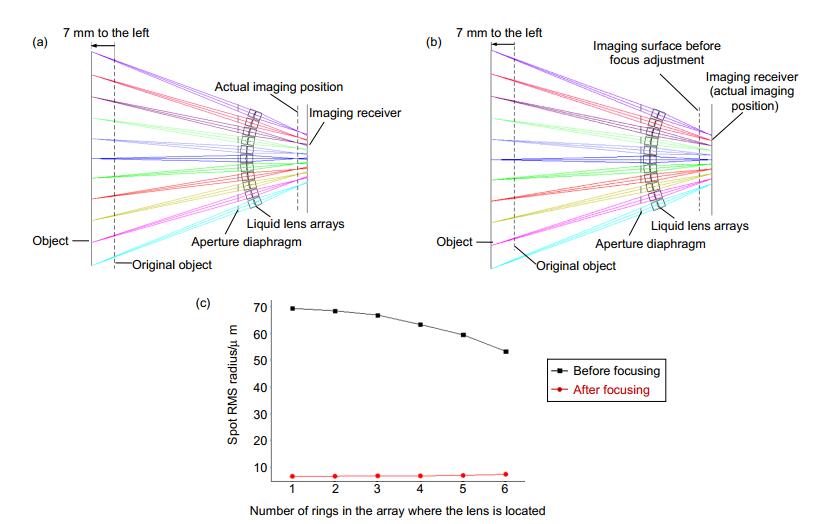-
摘要:
为解决仿生复眼系统不能自适应变焦的问题,提出了一种基于介电润湿液体透镜曲面阵列的可变焦仿生复眼系统。分析系统结构对成像性能的影响,计算系统的自适应变焦能力及相应像平面可移动范围。结果表明:系统成像的视场角随着基底曲率的增大而增大。相比于非均匀透镜阵列,均匀透镜阵列可明显降低系统的离焦像差。适当减小子透镜单元尺寸,也可以达到降低边缘透镜离焦像差的目的。当物距或者接收器位置发生改变时,通过调整子透镜单元焦距降低系统的离焦像差。系统接收器可移动范围为1.9 mm~15 mm。
 Abstract:
Abstract:To solve the problem that the bionic compound eye system can't zoom adaptively, a zoomable bionic compound eye system based on electrowetting-on-dielectric liquid lens cambered array is proposed. The influence of the system structure on the imaging performance is analyzed, and the adaptive zoom capability of the system and the moving range of the corresponding image plane are calculated. The results show that the field of view angle increases with the increase of the curvature of the base. Compared with the non-uniform lens array, the uniform lens array can significantly reduce the defocus aberration of the system. Reducing the size of the lens unit can also decrease the defocus aberration of the edge lens. When the object distance or receiver position is changed, the defocus aberration of the system will be reduced by adjusting the focal length of the lens unit. The movable range of the system receiver is 1.9 mm~15 mm.
-
Key words:
- optical design /
- electrowetting-on-dielectric /
- compound eye /
- liquid lens array /
- variable-focus
-

Overview: Insect compound eyes are natural multi-aperture curved optical system with large field of view, small size, high sensitivity, sensitivity to moving objects, and real-time image analysis and processing. Bionic compound eye system is an optical imaging system designed based on the imaging principle of insect compound eyes, which has been widely used in industrial detection, security, autonomous navigation, robot, and other fields.
Because the compound eye system has the characteristics of compact structure, high sensitivity and large field of view, it has great development and application potential. However, the traditional compound eye imaging system can not automatically zoom, and there is a mismatch between the compound eye system and the plane detector. In order to solve the problem that the compound eye system can not zoom adaptively and does not match the planar detector, this paper proposes a bionic compound eye system with adaptive zoom based on the cambered array of electrowetting-on-dielectric liquid lens. In the design of this compound eye system, the adaptive focusing ability of the electrowetting-on-dielectric liquid lens is applied. For the lens units in different positions, the shape of the liquid-liquid interface can be changed by adjusting the voltage of the liquid lens, to adjust the focal length of the lens unit, so that the lenses at different positions can image on a same plane. In this paper, the effects of the curved substrate, lens unit size, and ray incidence angle on imaging performance are analyzed through simulation. The simulation results show that the field of view angle of system imaging increases with the increase of the base curvature. After that, two kinds of compound eye systems with different arrays of uniform and non-uniform are compared by simulation analysis. By analyzing the spot diagram of simulation, compared with the non-uniform lens array, the uniform lens array can significantly reduce the defocus aberration of the system. Finally, the adaptive zoom capability of the bionic compound eye system is studied by analyzing the change of object distance or image distance. The results show that when the object distance or image distance changes, the focal length of the lens unit will be adjusted by controlling the working voltage, so that the image is refocused on the receiving detection surface, and the moving range of the image receiving surface is 1.9 mm~ 15 mm. The research in this paper will promote the development of the bionic compound eye system and provide theoretical basis for the rational use of liquid lens.
-

-
图 2 不同视场情况下,不同曲率仿复眼系统的成像效果。(a) R1=10 mm,正入射;(b) R2=15 mm,正入射;(c) R3=20 mm,正入射;(d) R1=10 mm,视场角20°;(e) R2=15 mm,视场角20°;(f) R3=20 mm,视场角20°;(g) R1=10 mm,视场角35°;(h) R2=15 mm,视场角35°;(i) R3=20 mm,视场角35°
Figure 2. Imaging effect of a compound eye system with different curvatures in different fields of view. (a) R1=10 mm, normal incidence; (b) R2=15 mm, normal incidence; (c) R3=20 mm, normal incidence; (d) R1=10 mm, field angle 20°; (e) R2=15 mm, field angle 20°; (f) R3=20 mm, field angle 20°; (g) R1=10 mm, field angle 35°; (h) R2=15 mm, field angle 35°; (i) R3=20 mm, field angle 35°
图 5 仿生复眼系统对物距变化的自适应性。(a) 调焦前,成像面偏离接收器;(b) 调焦后,成像面再次回到接收器位置;(c) 调焦前后各环透镜均方根半径
Figure 5. The adaptability of the bionic compound eye system to the changes in the object distance. (a) Before focusing, the imaging surface deviates from the receiver; (b) After focusing, the imaging surface returns to the receiver position again; (c) RMS of each ring lens before and after focusing
表 1 仿生复眼的各项参数
Table 1. Various parameters of bionic compound eye
Parameters Value Radius of base layer R/mm 15 Number of sub-eye M 37 Aperture of sub-eye D/mm 1 Index of conductive liquid n1 1.33 Index of insulating liquid n2 1.539 Image sensor change distance Δd/mm 3 Moving distance of object surface ΔL/mm 7 -
[1] 史成勇. 仿生曲面复眼系统设计及其图像处理研究[D]. 长春: 中国科学院长春光学精密机械与物理研究所, 2017: 1–102.
Shi C Y. Research on the design and image process of bioinspired spherical compound eye imaging system[D]. Changchun: Changchun Institute of Optics, Fine Mechanics and Physics Chinese Academy of Science, 2017: 1–102.
https://d.wanfangdata.com.cn/thesis/Y3353261 [2] 贾文武, 汪岳峰, 黄峰, 等. 像差对复眼透镜光束整形性能的影响分析[J]. 激光与光电子学进展, 2010, 47(11): 110801. https://www.cnki.com.cn/Article/CJFDTOTAL-JGDJ201011009.htm
Jia W W, Wang Y F, Huang F, et al. Effects of aberration on performance of fly's eye integrator[J]. Laser & Optoelectronics Progress, 2010, 47(11): 110801. https://www.cnki.com.cn/Article/CJFDTOTAL-JGDJ201011009.htm
[3] 王程, 朱向冰, 田丽伟, 等. 基于LED和复眼透镜的自适应前照灯的光学设计[J]. 激光与光电子学进展, 2015, 52(4): 042204. https://www.cnki.com.cn/Article/CJFDTOTAL-JGDJ201504024.htm
Wang C, Zhu X B, Tian L W, et al. Optical design of the adaptive front lighting system based on the led and the fly's-eye lens[J]. Laser & Optoelectronics Progress, 2015, 52(4): 042204. https://www.cnki.com.cn/Article/CJFDTOTAL-JGDJ201504024.htm
[4] 何建争. 球面仿生复眼的标定与定位研究[D]. 合肥: 中国科学技术大学, 2017: 1–71.
He J Z. Research on calibration and positioning of a spherical artificial compound eye[D]. Hefei: University of Science and Technology of China, 2017: 1–71.
http://cdmd.cnki.com.cn/Article/CDMD-10358-1017073425.htm [5] Leitel R, Brückner A, Buß W, et al. Curved artificial compound-eyes for autonomous navigation[J]. Proc SPIE, 2014, 9130: 91300H. http://spie.org/x648.xml?product_id=2052710
[6] Tanida J, Mima H, Kagawa K, et al. Application of a compound imaging system to odontotherapy[J]. Opt Rev, 2015, 22(2): 322–328. doi: 10.1007/s10043-015-0052-2
[7] Song Y M, Xie Y Z, Malyarchuk V, et al. Digital cameras with designs inspired by the arthropod eye[J]. Nature, 2013, 497(7447): 95–99. doi: 10.1038/nature12083
[8] Li Z W, Xiao J L. Mechanics and optics of stretchable elastomeric microlens array for artificial compound eye camera[J]. J Appl Phys, 2015, 117(1): 014904. doi: 10.1063/1.4905299
[9] Tanida J, Kumagai T, Yamada K, et al. Thin observation module by bound optics (TOMBO): concept and experimental verification[J]. Appl Opt, 2001, 40(11): 1806–1813. doi: 10.1364/AO.40.001806
[10] Tanida J, Shogenji R, Kitamura Y, et al. Color imaging with an integrated compound imaging system[J]. Opt Express, 2003, 11(18): 2109–2117. doi: 10.1364/OE.11.002109
[11] Miyatake S, Shogenji R, Miyamoto M, et al. Thin observation module by bound optics (TOMBO) with color filters[J]. Proc SPIE, 2004, 5301: 7–12. doi: 10.1117/12.533388
[12] Hornsey R, Thomas P, Wong W, et al. Electronic compound-eye image sensor: construction and calibration[J]. Proc SPIE, 2004, 5301: 13–24. doi: 10.1117/12.526811
[13] Duparré J, Radtke D, Tünnermann A. Spherical artificial compound eye captures real images[J]. Proc SPIE, 2007, 6466: 64660K. doi: 10.1117/12.696258
[14] Floreano D, Pericet-Camara R, Viollet S, et al. Miniature curved artificial compound eyes[J]. Proc Natl Acad Sci, 2013, 110(23): 9267–9272. doi: 10.1073/pnas.1219068110
[15] 郝永平, 赵龙飞, 张嘉易. 非球面变焦距曲面复眼的优化研究[J]. 红外与激光工程, 2015, 44(1): 157–161. doi: 10.3969/j.issn.1007-2276.2015.01.027
Hao Y P, Zhao L F, Zhang J Y. Optimal research of aspherical zoom curved compound eye[J]. Infrared Laser Eng, 2015, 44(1): 157–161. doi: 10.3969/j.issn.1007-2276.2015.01.027
[16] Shahini A, Jin H, Zhou Z X, et al. Toward individually tunable compound eyes with transparent graphene electrode[J]. Bioinspir Biomim, 2017, 12(4): 046002. doi: 10.1088/1748-3190/aa7084
[17] Cheng Y, Cao J, Meng L T, et al. Reducing defocus aberration of a compound and human hybrid eye using liquid lens[J]. Appl Opt, 2018, 57(7): 1679–1688. doi: 10.1364/AO.57.001679
[18] 曹杰, 郝群, 肖宇晴, 等. 一种基于液体透镜的自适应调焦方法及系统: 106814450A[P]. 2017-06-09.
[19] Cao A X, Wang J Z, Pang H, et al. Design and fabrication of a multifocal bionic compound eye for imaging[J]. Bioinspir Biomim, 2018, 13(2): 026012. doi: 10.1088/1748-3190/aaa901
[20] 朱凌峰, 孔梅梅, 宋驰, 等. 电润湿双液体透镜的界面面型分析[J]. 光电工程, 2016, 43(12): 65–71. doi: 10.3969/j.issn.1003-501X.2016.12.011
Zhu L F, Kong M M, Song C, et al. Analysis on the interface shape of double liquid lens based on electro-wetting technology[J]. Opto-Electron Eng, 2016, 43(12): 65–71. doi: 10.3969/j.issn.1003-501X.2016.12.011
[21] Kuiper S, Hendriks B H W. Variable-focus liquid lens for miniature cameras[J]. Appl Phys Lett, 2004, 85(7): 1128–1130. doi: 10.1063/1.1779954
[22] Li L, Xiao L, Wang J H, et al. Movable electrowetting optofluidic lens for optical axial scanning in microscopy[J]. Opto-Electron Adv, 2019, 2(2): 180025. http://www.zhangqiaokeyan.com/academic-journal-cn_photoelectric-progress-english_thesis/0201272375194.html
[23] 赵瑞, 田志强, 刘启超, 等. 介电润湿液体光学棱镜[J]. 光学学报, 2014, 34(12): 1223003. https://www.cnki.com.cn/Article/CJFDTOTAL-GXXB201412042.htm
Zhao R, Tian Z Q, Liu Q C, et al. Electrowetting-based liquid prism[J]. Acta Opt Sin, 2014, 34(12): 1223003. https://www.cnki.com.cn/Article/CJFDTOTAL-GXXB201412042.htm
-


 E-mail Alert
E-mail Alert RSS
RSS

 下载:
下载:








